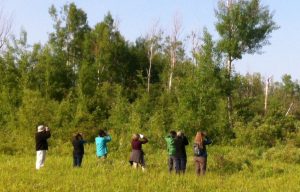Birds are in Trouble!
The populations of many bird species are declining. The number of  individuals of many species is half what it was 4 decades ago and is expected to decrease by another half in the next 40 years. Local Ornithologist (professional bird nerd), Andrew Jobes, has written the blog posts for our monthly newsletter since last June. He’s led public bird walks in Peterborough for several years and has noticed that, although the number of species observed remains similar from year to year, the number of individual birds seen has decreased a lot over the past decade or so.
individuals of many species is half what it was 4 decades ago and is expected to decrease by another half in the next 40 years. Local Ornithologist (professional bird nerd), Andrew Jobes, has written the blog posts for our monthly newsletter since last June. He’s led public bird walks in Peterborough for several years and has noticed that, although the number of species observed remains similar from year to year, the number of individual birds seen has decreased a lot over the past decade or so.
Several factors can contribute to bird population decline, including tropical deforestation on the wintering grounds, habitat loss and fragmentation on the breeding grounds, climate change, outdoor cats, collisions with buildings, and pesticide use. Scientists all over the world are studying birds to identify causes of population decline and solutions for it. But there are only so many scientists out there, and the world is a big place.
 Citizen Science to the Rescue
Citizen Science to the Rescue
Many large-scale research programs that have been around for decades and cover entire continents are built on data collected by citizens. It’s often these programs that have helped scientists detect and understand population trends. Some programs require advanced bird identification skills, while others are readily accessible to beginner birdwatchers. All provide training, protocols, and data sheets. Here’s an overview of a few that you could participate in to contribute to scientists’ understanding of what’s going on:
- Project Feeder Watch is a fun program that you can do from the comfort of your own home. Coordinated by Bird Studies Canada and Cornell University, it involves systematically counting and documenting the kinds and numbers of birds at your feeders from November through April and submitting your observations to Bird Studies Canada. Participants receive a number of support materials.
- The annual Christmas Bird Count takes place a few days before and after Christmas day. It involves documenting the numbers of individuals of every species seen or heard during that period and within a specific area. You can contribute your own local observations or join a larger group for a 1-day count, in which teams are responsible for driving around a defined area for the day and documenting their observations. These outings can be fun and are a great way for beginner birders to learn from more experienced ones. The day ends with the whole group gathering and sharing their counts over refreshments.
- The Breeding Bird Survey is run by the USGS Patuxent Wildlife Research Center. It requires the ability to identify all local bird species by eye and ear and involved driving an assigned route one morning every year for a minimum of 3-5 years. Every route has 50 stops 800 metres apart at which a 3-minute survey is completed. It takes about 5 hours to complete a route and, although intense, they are a fun challenge for the eager!
- The Great Backyard Bird Count is run by Cornell University, Audubon, and Bird Studies Canada. This annual event spans 4 days, and participants can count birds where they are for a few minutes on one day or all day for all 4 days, as they wish.
If you live or have a cottage on or near a lake or marsh, or like to play in the dark, you might like to explore programs such as the Canadian Lakes Loon Survey, the Marsh Monitoring Program, or the Nocturnal Owl Survey. Visit https://www.birdscanada.org/volunteer/programmap/index.jsp?lang=EN to learn more.
What Else Can I do to Help?
- support organizations the help protect birds by becoming a member, participating in their programs, and/or making a donation
- take steps to reduce window collisions at your home
- plant trees, shrubs, and flowers that support birds by providing food and shelter for them
- keep your cat indoors
- maintain a bird bath and other water features
- maintain your bird feeder(s) with high-quality food
